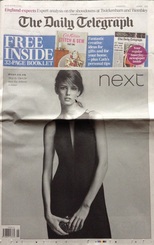So there she was on the front page that was sent to the television stations and tweeted last night; a shaft of colour at the heart of the stories the Telegraph believes are the most important for us to know about today: the EU and immigration, the murder of Lee Rigby, overpaid footballers. And at the top there was another pretty woman - Jennifer Lawrence in a puff for an interview in the weekly review.

In choosing their Saturday reading, our shoppers were expected to decide between home-alone children in the Times, Isis in the Independent, a hospital crisis in the Guardian, VIP child abuse in the Mail - and an advertisement for a dress.
The Times was the last paper to swap advertising for editorial on the front page in 1966. It was a good commercial decision. Now papers are reversing the process with increasing regularity. It is a bad commercial decision.
There is no disputing that newspapers need advertising to survive. In the difficult financial climate of the past six years, businesses have cut back on their promotion budgets and, with newspapers desperate for a bigger slice of the smaller cake, savvy advertisers have been playing hard to get.
Full-page ads are expensive and readers are apt to turn over. A cheaper 33x5 in a broadsheet or a 25x4 in a tabloid means there is editorial on the page to keep the potential customer's attention, yet the ad still dominates.
So far, so clever.
With the market on their side, advertisers have become more demanding and we have seen a proliferation of hideous shapes. The worst of these so far have been those where the ad starts top left of a spread, runs across the centre - cutting the editorial in half - and then finishes bottom right.

This is an unwise precedent, but at least by the time the reader gets to the page he or she will have bought the paper.
The far greater sin is to sell the front page.
Newspapers may be desperate for advertising, but they are even more desperate for sales. Without sales, advertisers won't want to know - or will make increasingly wild demands about what they get for their money. That will in turn make the product increasingly less attractive and everyone ends up the loser: newspaper, advertiser, reader.
The front page is a newspaper's shop window. You'd have thought that was so obvious that it wasn't worth saying. If it pulls down the blinds so that the customer can't get a glimpse of what's on offer, that customer will go elsewhere. No casual reader will buy the Telegraph today on the basis of a monochrome dress ad.
Jason Seiken wants to rule a digital world and he may have given up on street sales. They may well account for such a small proportion of circulation that the income from the front-page ad outstrips the lost revenue from casual sales.
But a newspaper sells on the basis of its journalism. To hide it under a commercial wrapper is to suggest that it is not valued. And from an organisation that is in the process of decimating its editorial staff, that's a worrying thought.
Editor's blog: Why is it "inevitable" that change equals job cuts?



 RSS Feed
RSS Feed


